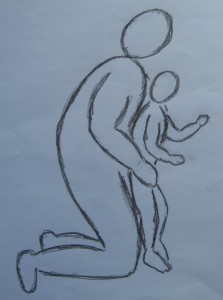Those who hope in the Lord will renew their strength. They will soar on wings like eagles; they will run and not grow weary, they will walk and not be faint.
– Isaiah 40:31
Stilling: Being present to God
Begin with a simple stilling exercise.
You may want to light a candle, or say a short prayer as you intentionally place yourself in the presence of the Holy One.
Find a comfortable position and be still for a couple of minutes. Concentrate on your breathing – slowly, in and out. Relax your muscles. Don’t worry about any thoughts that come into your head; acknowledge them, then come back to your stilling exercise.
Say the following prayer as you commit to being in God’s presence:
Dear God,
You sustain me and feed me;
Like a shepherd you guide me;
You lead me to an oasis of green,
To lie down by restful waters.
Dwell in me that I may dwell in you.
From Jim Cotter, Psalms for a pilgrim people, Psalm 23
Muscle tone
As a paediatrician, I am often referred young children who are delayed in their development, including those who are slow in learning to walk. Sometimes there is a genuine underlying medical disorder preventing them from acquiring those skills. These children typically fall into one of two broad groups: those with low muscle tone (hypotonia) and those with high muscle tone (hypertonia).
Children with hypotonia have weak, floppy muscles which are unable to support their weight effectively. We find this, for example, in children with Down syndrome. Those with hypertonia, such as children with some forms of cerebral palsy, have stiff, inflexible muscles. They find it equally difficult to walk, but for different reasons: their muscles, though stiff, are still weak, and they cannot easily achieve the coordination and balance to stand upright.
When I am assessing a young child’s ability to stand and walk, I need to provide him with support and a stable base so he feels secure. In order to do this, I typically sit or kneel on the floor, with the child sitting between my legs, his back to me. When the child is sitting like that, he feels secure and safe. Those with high muscle tone often relax, enabling me to move their legs and assess the muscle strength.
Once I have the child properly relaxed, I will gently lift him to a more upright position, his trunk still supported against me, my arms around him, keeping him from falling. In that position, the child can feel secure and is able to take some weight on his legs, perhaps even taking some preliminary, supported steps.
 I often think of God being like that with me. In my spiritual development, I may feel weak and hypotonic, unable to stand up in the face of difficult challenges. Or I may try too hard, my hypertonic spiritual muscles getting in the way of my attempts to go forward. I may feel insecure and afraid of falling or getting things wrong, or I may have already been hurt by life’s events and be feeling a bit bruised and battered. In all those situations, I picture God as a heavenly paediatrician, holding me securely in his embrace, giving me the strength and courage to take those first, tentative steps.
I often think of God being like that with me. In my spiritual development, I may feel weak and hypotonic, unable to stand up in the face of difficult challenges. Or I may try too hard, my hypertonic spiritual muscles getting in the way of my attempts to go forward. I may feel insecure and afraid of falling or getting things wrong, or I may have already been hurt by life’s events and be feeling a bit bruised and battered. In all those situations, I picture God as a heavenly paediatrician, holding me securely in his embrace, giving me the strength and courage to take those first, tentative steps.
Prayer: Encountering God
Choose one of the two exercises below as a contemplative approach to prayer: Encountering God through a prayer of Examen or Encountering God in Scripture (Lectio Divina)
Response: Walking Prayer[1]
This form of prayer is an extension of centring prayer. In it we respond to God by consciously slowing down and becoming aware of our body and our movements, recognising we are in the presence of the Holy One who made us.
Find a place where you can walk slowly and undisturbed – either in a circle or in a straight line (no more than 4-5 metres would be appropriate). It can help to be barefoot for this exercise.
Stand still at the start of your walk, and concentrate on your breathing while you stand. Stay still for a minute or two.
When you feel ready, very slowly start to walk along your line. Concentrate on each step in turn – gradually lift your foot, heel first, then the sole of your foot, and finally your toes; gently swing your foot forward a few inches and slowly place it down, heel first, then the sole, finally your toes, shifting your centre of gravity as you do so.
As you walk, focus on the sensations you feel – the tensions, movements and relaxation of different muscle group, your balance and centre of gravity, the pressure through your feet on the floor.
Intentionally slow down your movements as much as you are able. Ideally you want to take at least 15-20 minutes to walk the 4-5 metres.
When you reach the end of your line (or your starting point on the circle) stop and stand still for a minute or two, concentrating again on your breathing.
Closing: Going on in God’s presence
Finish your time by saying the Lord’s Prayer.
[1] Based on Anthony de Mello, Sadhana

Leave a reply